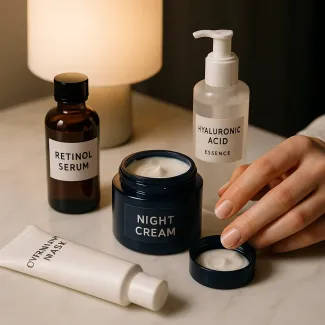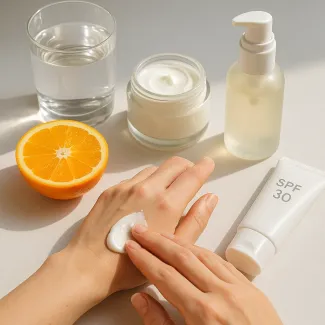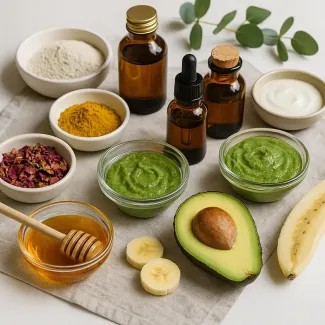
Rejuvenate Your Skin While You Sleep with Proven Nighttime Care
Unlock the power of nightly regeneration with targeted skincare rituals and expert tips
Your skin goes through its most intensive renewal process during the night. While you sleep, your body shifts into repair mode—producing collagen, restoring hydration, and repairing environmental damage. Establishing a nighttime skincare routine that's both intentional and effective is essential to support this natural rhythm and enhance your skin’s long-term health and appearance.
Understanding what your skin needs at night is more than just applying a cream before bed. It’s about aligning your routine with your skin’s biological repair cycle, selecting products that truly nourish, and creating habits that allow your skin to breathe and restore itself. In this guide, you’ll find an in-depth breakdown of effective steps, ingredient highlights, and advice tailored to your skin’s nighttime needs—whether you’re dealing with early signs of aging, dehydration, dullness, or breakouts.
How your skin behaves during sleep and why timing matters
Our bodies follow a circadian rhythm that affects every organ—including the skin. At night, blood flow to the skin increases, allowing better delivery of oxygen and nutrients. Cell proliferation also peaks, especially between 11 p.m. and 4 a.m., making this the ideal window for skin renewal. This is the time when skin is most receptive to treatments such as serums, retinoids, and deep moisturizers.
Unlike daytime, when the focus is on protection from UV rays and pollutants, nighttime care focuses on repair. This means your nighttime products can be more potent, with fewer concerns about sun sensitivity. The barrier function of the skin is also weaker at night, which allows active ingredients to penetrate more deeply—making your choices and timing particularly critical.
Building the ideal nighttime skincare routine step by step
An effective evening skincare routine is built on consistency, layering, and patience. It doesn’t have to be overly complicated, but each step should serve a purpose. Here's how to structure it to support maximum overnight recovery:
Start with a thorough double cleanse to remove buildup
Even if you don’t wear makeup, your skin accumulates oil, SPF, pollution particles, and sweat throughout the day. Start your evening ritual with a double cleanse. Begin with an oil-based cleanser to dissolve sunscreen and impurities, followed by a gentle water-based cleanser that suits your skin type.
This two-step process is essential for ensuring your skin is clean enough to fully absorb the active ingredients in the next stages. For those with oily or acne-prone skin, opting for a non-comedogenic formula is key. Sensitive skin types should choose sulfate-free options with calming botanicals like chamomile or centella asiatica.
Use exfoliating acids two to three times a week
To boost cell turnover and maintain a luminous complexion, incorporate chemical exfoliants into your weekly routine. Ingredients like glycolic acid, lactic acid, or mandelic acid help remove dead skin cells that build up over time and can block the absorption of other products.
Avoid physical scrubs at night as they can create microtears and interfere with your skin’s regeneration process. Always follow exfoliation with deep hydration and barrier support to avoid over-sensitizing the skin.
Apply a hydrating essence or toner with soothing ingredients
After cleansing and optional exfoliation, apply a hydrating toner or essence to rebalance your skin’s pH and prep the surface for serums. Look for ingredients like hyaluronic acid, panthenol (vitamin B5), and aloe vera to deliver moisture while calming any irritation.
This step acts as a moisture magnet and gives your serums better slip, allowing them to penetrate deeper without being diluted by water.
Choose targeted serums that work while you sleep
Serums are the core of any night skincare routine, as they’re packed with concentrated active ingredients. Depending on your skin goals, here are some of the best nighttime serum options:
- Retinol or retinaldehyde for reducing fine lines and improving skin texture.
- Niacinamide for refining pores, boosting barrier strength, and fading hyperpigmentation.
- Peptides to stimulate collagen synthesis and firmness.
- Tranexamic acid for discoloration and melasma.
- Bakuchiol, a natural alternative to retinol, for those with sensitive skin.
Always apply serums on slightly damp skin and wait 30–60 seconds before layering your moisturizer.
Seal in hydration with a nourishing night cream
The final step in your routine should be a deeply hydrating moisturizer that locks in all the previous layers and supports the skin barrier. Look for ingredients like ceramides, squalane, shea butter, or glycerin. These help trap moisture and strengthen the skin’s lipid layer.
If you’re using potent actives like retinoids or acids, a richer cream can also help buffer their effects and minimize irritation. For oilier skin types, a gel-cream texture might feel more comfortable without clogging pores.
Add an overnight mask 1–2 times per week
To boost hydration and recovery, include an overnight sleeping mask once or twice per week. These are usually thicker than a regular moisturizer and infused with restorative ingredients like panthenol, beta-glucan, or vitamin E.
They work best when applied after your usual night cream, sealing in your routine and delivering prolonged nourishment through the night.
Ingredients that amplify nighttime skin repair
Nighttime is when your skin can truly benefit from ingredients that might be too strong for daytime use or require slow absorption. Some of the most effective ingredients for night repair include:
- Retinoids: Boost cell turnover, fade fine lines and improve clarity.
- Hyaluronic Acid: Draws moisture into the skin and supports elasticity.
- Ceramides: Strengthen the skin barrier and prevent trans-epidermal water loss.
- Vitamin C (in stabilized night formulas): Promotes brightness and collagen.
- Centella Asiatica (Cica): Calms inflammation and accelerates wound healing.
- Squalane: Mimics skin's natural oils for deep but lightweight hydration.
Choosing products with a combination of these clinically supported ingredients ensures your skin gets what it needs to regenerate while you rest.
Tailoring your nighttime routine to your skin type
Every skin type benefits from a solid nighttime routine, but customizing your steps and products to match your skin’s current needs makes all the difference:
For dry or sensitive skin
Use fragrance-free, non-irritating cleansers, skip harsh acids, and focus on hydrating serums with panthenol, hyaluronic acid, and ceramides. Rich creams with fatty acids like jojoba or avocado oil help restore comfort and barrier integrity.
For oily or acne-prone skin
Lightweight formulas are key. Use BHA (salicylic acid) two to three times a week to keep pores clean and prevent breakouts. Gel moisturizers with niacinamide and green tea extract offer soothing and balancing benefits.
For combination skin
Mix and match textures: a light serum followed by a medium-weight moisturizer can balance oily and dry zones. Avoid over-stripping the skin with aggressive cleansers or toners.
For mature skin
Focus on collagen support and moisture retention. Use retinoids, peptides, and antioxidant serums, followed by emollient-rich creams that reduce transepidermal water loss. Don't skip the neck and décolleté.
Nighttime skin habits beyond products
Your skin doesn't operate in isolation—lifestyle choices, stress, and sleep quality all influence your complexion. Here are non-product habits that significantly boost overnight regeneration:
- Sleep 7–9 hours: Your skin needs this downtime to complete its repair cycles.
- Silk pillowcases: These reduce friction and help prevent fine lines.
- Cool sleeping environment: Prevents excessive sweating and inflammation.
- Humidifiers in winter: Combat dry indoor air that can dehydrate your skin.
- No screens an hour before bed: Blue light interferes with melatonin, which also plays a role in skin healing.
These supportive practices create the best environment for your skin to thrive overnight.
Common mistakes that sabotage nighttime skincare
Even well-meaning skincare routines can fall short if they include certain missteps. Avoid these nighttime skincare pitfalls:
- Applying products in the wrong order (light to heavy is best).
- Overusing actives like exfoliants or retinol without balancing with hydration.
- Skipping cleansing after a day with sunscreen or makeup.
- Sleeping with dirty pillowcases, which can harbor bacteria and clog pores.
- Using day products at night, like those with SPF or fragrances that can irritate during repair.
Being mindful of these small but impactful choices enhances the effectiveness of your entire routine.
Creating consistency and long-term results
The key to a successful nighttime skincare routine isn’t in owning dozens of products—it’s about choosing well, applying regularly, and adjusting as your skin evolves. Seasonal changes, stress, hormonal shifts, or age all influence your skin’s needs, so don’t hesitate to modify your routine every few months.
Track your skin’s progress by observing how it looks and feels in the morning. Over time, consistent care paired with smart ingredient selection leads to fewer breakouts, smoother texture, improved tone, and a natural glow that radiates health.
Incorporating natural oils for overnight restoration
Natural plant-based oils can serve as an extra step after your moisturizer or even replace it for some skin types. Here are some of the best options for overnight nourishment:
- Rosehip oil: Rich in vitamins A and C, ideal for brightening and reducing pigmentation.
- Jojoba oil: Closest to the skin’s own sebum, ideal for all skin types.
- Marula oil: Antioxidant-rich and deeply hydrating without being greasy.
- Argan oil: Helps soften fine lines and protect against dryness.
Warm a few drops between your palms and gently press into the skin as the final step before bed.
Adapting your night routine during hormonal shifts
Hormonal changes—whether due to age, stress, menstruation, pregnancy or menopause—can impact your skin in significant ways. During these shifts, nighttime skincare can serve as both treatment and support:
- For hormonal acne, include niacinamide and salicylic acid.
- For dryness linked to menopause, layer hyaluronic acid, ceramides, and squalane.
- For pigmentation shifts, use azelaic acid, retinol, or tranexamic acid.
Paying attention to your hormonal cycle allows for dynamic adjustments that address your skin’s evolving needs without overwhelming it.

